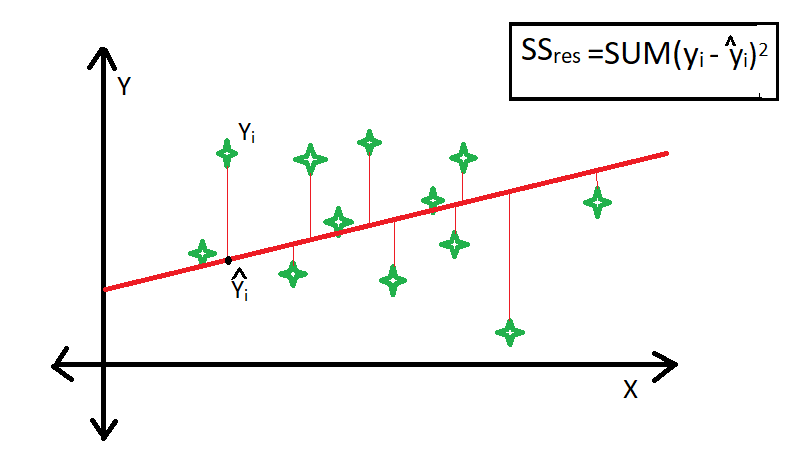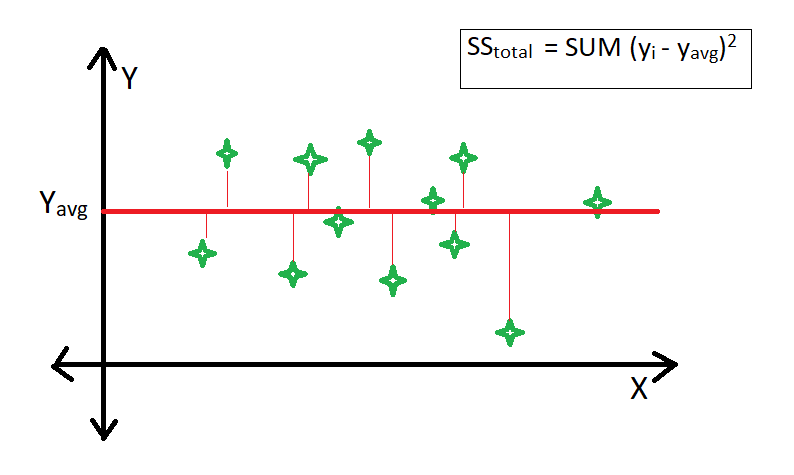R-squared Regression Analysis in R Programming
Last Updated :
19 Dec, 2023
For the prediction of one variable’s value(dependent variable) through other variables (independent variables) some models are used that are called regression models. For further calculating the accuracy of this prediction another mathematical tool is used, which is R-squared Regression Analysis or the coefficient of determination. The value of R-squared is between 0 and 1. If the coefficient of determination is 1 (or 100%) means that the prediction of the dependent variable has been perfect and accurate.
R-square is a comparison of the residual sum of squares (SSres) with the total sum of squares(SStot). The residual sum of squares is calculated by the summation of squares of perpendicular distance between data points and the best-fitted line.

The total sum of squares is calculated by the summation of squares of perpendicular distance between data points and the average line.

Formula for R-squared Regression Analysis
The formula for R-squared Regression Analysis is given as follows,
where,  : experimental values of the dependent variable
: experimental values of the dependent variable  : the average/mean
: the average/mean  : the fitted value
: the fitted value
Find the Coefficient of Determination(R) in R
It is very easy to find out the Coefficient of Determination(R) in the R Programming Language.
The steps to follow are:
- Make a data frame in R.
- Calculate the linear regression model and save it in a new variable.
- The so calculated new variable’s summary has a coefficient of determination or R-squared parameter that needs to be extracted.
R
exam <- data.frame(name = c("ravi", "shaily",
"arsh", "monu"),
math = c(87, 98, 67, 90),
estimated = c(65, 87, 56, 100))
exam
|
Output:
name math estimated
1 ravi 87 65
2 shaily 98 87
3 arsh 67 56
4 monu 90 100
Make model and calculate the summary of the model
R
model = lm(math~estimated, data = exam)
summary(model)
|
Output:
Call:
lm(formula = math ~ estimated, data = exam)
Residuals:
1 2 3 4
7.421 7.566 -8.138 -6.848
Coefficients:
Estimate Std. Error t value Pr(>|t|)
(Intercept) 47.5074 24.0563 1.975 0.187
estimated 0.4934 0.3047 1.619 0.247
Residual standard error: 10.62 on 2 degrees of freedom
Multiple R-squared: 0.5673, Adjusted R-squared: 0.3509
F-statistic: 2.622 on 1 and 2 DF, p-value: 0.2468
Output:
[1] 0.5672797
Note: If the prediction is accurate the R-squared Regression value generated is 1.
- We’re using a linear regression model to understand the relationship between “math” scores and the variable “estimated.
- We’re using a linear regression model to understand the relationship between “math” scores and the variable “estimated.
- Residuals are the differences between actual “math” scores and what our model predicts. We have these differences for four observations.
- The intercept (where the line crosses the y-axis) is estimated to be 47.51. The coefficient for “estimated” is 0.49, suggesting that for each unit increase in “estimated,” the predicted “math” score increases by about 0.49 units.
- The p-values for both the intercept and “estimated” aren’t very low (0.187 and 0.247, respectively). This means that these coefficients may not be significantly different from zero at a standard significance level.
- This is an estimate of how spread out the residuals are, and here it’s about 10.62.
- The R-squared value of 0.5673 suggests that our model explains around 56.73% of the variation in “math” scores.
- This is a version of R-squared that considers the number of predictors. Here, it’s 0.3509 after adjusting.
- The F-statistic tests if our model is generally significant. A p-value of 0.2468 suggests the overall model might not be statistically significant.
R
exam <- data.frame(name = c("ravi", "shaily",
"arsh", "monu"),
math = c(87, 98, 67, 90),
estimated = c(87, 98, 67, 90))
exam
model = lm(math~estimated, data = exam)
summary(model)
|
Output:
name math estimated
1 ravi 87 87
2 shaily 98 98
3 arsh 67 67
4 monu 90 90
Call:
lm(formula = math ~ estimated, data = exam)
Residuals:
1 2 3 4
2.618e-15 -2.085e-15 -1.067e-15 5.330e-16
Coefficients:
Estimate Std. Error t value Pr(>|t|)
(Intercept) 0.000e+00 9.494e-15 0.000e+00 1
estimated 1.000e+00 1.101e-16 9.086e+15 <2e-16 ***
---
Signif. codes: 0 ‘***’ 0.001 ‘**’ 0.01 ‘*’ 0.05 ‘.’ 0.1 ‘ ’ 1
Residual standard error: 2.512e-15 on 2 degrees of freedom
Multiple R-squared: 1, Adjusted R-squared: 1
F-statistic: 8.256e+31 on 1 and 2 DF, p-value: < 2.2e-16
The summary function give all the information of the model.
Residual standard error: 2.512e-15 on 2 degrees of freedom
Multiple R-squared: 1, Adjusted R-squared: 1
F-statistic: 8.256e+31 on 1 and 2 DF, p-value: < 2.2e-16
This model appears to be an impeccable fit for the data. The extremely tiny residual standard error indicates almost perfect prediction accuracy.
- The R-squared and adjusted R-squared values of 1 signify that the model explains 100% of the variation in “math” scores.
- The colossal F-statistic with an extremely low p-value reinforces the idea that the model is highly significant.
Limitation of Using R-square Method
- The value of r-square always increases or remains the same as new variables are added to the model, without detecting the significance of this newly added variable (i.e value of r-square never decreases on the addition of new attributes to the model). As a result, non-significant attributes can also be added to the model with an increase in r-square value.
- This is because SStot is always constant and the regression model tries to decrease the value of SSres by finding some correlation with this new attribute and hence the overall value of r-square increases, which can lead to a poor regression model.
Like Article
Suggest improvement
Share your thoughts in the comments
Please Login to comment...